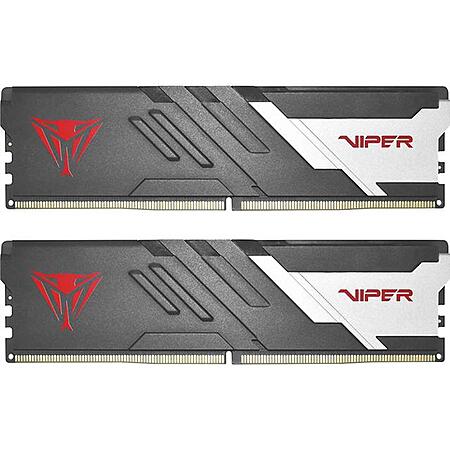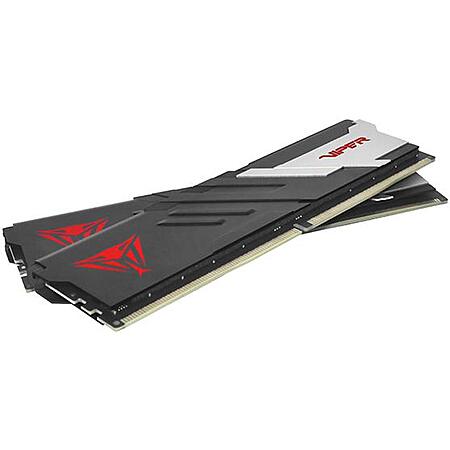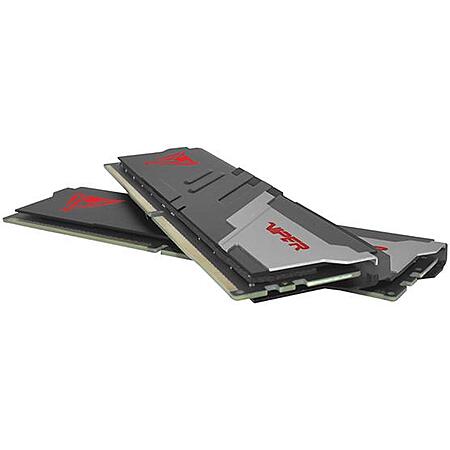expiredEragorn | Staff posted Jan 15, 2025 06:19 PM
Item 1 of 4
Item 1 of 4
expiredEragorn | Staff posted Jan 15, 2025 06:19 PM
64GB (2x 32GB) Patriot Memory Viper Venom DDR5 6400 CL32 Desktop Memory
+ Free Shipping$135
$170
20% offNewegg
Visit NeweggGood Deal
Bad Deal
Save
Share







Leave a Comment
Top Comments
Memory specs sheet: https://cdn.prod.websit
Basic am5 memory overclocking/tuning information: https://www.youtube.com/watch?v=Xcn_nvW
On am5, these are the settings I'd personally recommend as a starting point (primarily derived from buildzoid ddr5 6000 hynix fallback timings, simply taking the loosest between a or m die since I don't know which this particular memory kit is):
Ddr5 speed set to 6000
uclk div1 mode set to uclk=memclk (mclk will be 3000, uclk will be 3000)
FCLK left on auto (2000)
Voltages:
VSOC 1.25v (if you disable your igpu in bios 1.2v should be possible unless you get unlucky)
DRAM VDD 1.4v
DRAM VDDQ 1.4v
VDDIO 1.4v
VDDP 0.99v (0.95 should be easily possible, but I've heard of very rare anecdotal cases where stability suffers below 1v even at ddr5 6000)
Timings:
tCL 32 (30 easily possible)
tRCDWR 40
tRCDRD 40
tRP 40
tRAS 48 (40 should be possible, but dual rank can sometimes have issues with low tras)
tRC 88
tWR 48
tRFC 512 (if your memory gets exceptionally hot, you might want to raise to 544)
tRFC2 auto
tRFCSB auto
tREFI 40000 (if you memory stays below 60C raise to 50000, if it goes over 65C lower to 30000)
tRTP 16
tRRDL 8
tRRDS 8
tFAW 32
tWTRL 16
tWTRS 6
tRDRDSCL 4
tRDRDSC 1
tRDRDSD 6
tRDRDDD 6
tWRWRSCL 4
tWRWRSC 1
tWRWRSD 8
tWRWRDD 8
tWRRD 4
tRDWR 16
These are a basic starting point that should be perfectly stable unless you really lose the silicon lottery, but make sure to thoroughly stress test your system. Running memtest86 (free) from a flashdrive is good as an initial test to check for obvious hardware defects in all memory chips, but it's not very good at picking up errors due to overclocking. For free stress testing, at a minimum I'd recommend prime95 large ffts (4+hrs, 8+ preferred) and y-cruncher vt3 (4+hrs, 8+ preferred). For additional validation you could try occt memory and cpu+ram large dataset tests, hci memtest, and tm5 (testmem5) with 1usmus and absolut configs.
18 Comments
Sign up for a Slickdeals account to remove this ad.
People that tell you "unless you're doing some extreme video editing, you'll NEVER even notice a difference" - this is wrong.
We're simple creatures and I may not count exactly how long it takes for steam to pop up on my screen when I click the icon, but it's about double to triple the speed now. And that probably sounds silly, like who cares, but it's the little things and you will definitely notice a boost of speed in your otherwise meaningless tasks. So if you're doing a new build and looking at decent 32gb set for around $100, spend a few more on this. You'll thank yourself.
Sign up for a Slickdeals account to remove this ad.
Memory specs sheet: https://cdn.prod.websit
Basic am5 memory overclocking/tuning information: https://www.youtube.com/watch?v=Xcn_nvW
On am5, these are the settings I'd personally recommend as a starting point (primarily derived from buildzoid ddr5 6000 hynix fallback timings, simply taking the loosest between a or m die since I don't know which this particular memory kit is):
Ddr5 speed set to 6000
uclk div1 mode set to uclk=memclk (mclk will be 3000, uclk will be 3000)
FCLK left on auto (2000)
Voltages:
VSOC 1.25v (if you disable your igpu in bios 1.2v should be possible unless you get unlucky)
DRAM VDD 1.4v
DRAM VDDQ 1.4v
VDDIO 1.4v
VDDP 0.99v (0.95 should be easily possible, but I've heard of very rare anecdotal cases where stability suffers below 1v even at ddr5 6000)
Timings:
tCL 32 (30 easily possible)
tRCDWR 40
tRCDRD 40
tRP 40
tRAS 48 (40 should be possible, but dual rank can sometimes have issues with low tras)
tRC 88
tWR 48
tRFC 512 (if your memory gets exceptionally hot, you might want to raise to 544)
tRFC2 auto
tRFCSB auto
tREFI 40000 (if you memory stays below 60C raise to 50000, if it goes over 65C lower to 30000)
tRTP 16
tRRDL 8
tRRDS 8
tFAW 32
tWTRL 16
tWTRS 6
tRDRDSCL 4
tRDRDSC 1
tRDRDSD 6
tRDRDDD 6
tWRWRSCL 4
tWRWRSC 1
tWRWRSD 8
tWRWRDD 8
tWRRD 4
tRDWR 16
These are a basic starting point that should be perfectly stable unless you really lose the silicon lottery, but make sure to thoroughly stress test your system. Running memtest86 (free) from a flashdrive is good as an initial test to check for obvious hardware defects in all memory chips, but it's not very good at picking up errors due to overclocking. For free stress testing, at a minimum I'd recommend prime95 large ffts (4+hrs, 8+ preferred) and y-cruncher vt3 (4+hrs, 8+ preferred). For additional validation you could try occt memory and cpu+ram large dataset tests, hci memtest, and tm5 (testmem5) with 1usmus and absolut configs.
Memory specs sheet: https://cdn.prod.websit
Basic am5 memory overclocking/tuning information: https://www.youtube.com/watch?v=Xcn_nvW
On am5, these are the settings I'd personally recommend as a starting point (primarily derived from buildzoid ddr5 6000 hynix fallback timings, simply taking the loosest between a or m die since I don't know which this particular memory kit is):
Ddr5 speed set to 6000
uclk div1 mode set to uclk=memclk (mclk will be 3000, uclk will be 3000)
FCLK left on auto (2000)
Voltages:
VSOC 1.25v (if you disable your igpu in bios 1.2v should be possible unless you get unlucky)
DRAM VDD 1.4v
DRAM VDDQ 1.4v
VDDIO 1.4v
VDDP 0.99v (0.95 should be easily possible, but I've heard of very rare anecdotal cases where stability suffers below 1v even at ddr5 6000)
Timings:
tCL 32 (30 easily possible)
tRCDWR 40
tRCDRD 40
tRP 40
tRAS 48 (40 should be possible, but dual rank can sometimes have issues with low tras)
tRC 88
tWR 48
tRFC 512 (if your memory gets exceptionally hot, you might want to raise to 544)
tRFC2 auto
tRFCSB auto
tREFI 40000 (if you memory stays below 60C raise to 50000, if it goes over 65C lower to 30000)
tRTP 16
tRRDL 8
tRRDS 8
tFAW 32
tWTRL 16
tWTRS 6
tRDRDSCL 4
tRDRDSC 1
tRDRDSD 6
tRDRDDD 6
tWRWRSCL 4
tWRWRSC 1
tWRWRSD 8
tWRWRDD 8
tWRRD 4
tRDWR 16
These are a basic starting point that should be perfectly stable unless you really lose the silicon lottery, but make sure to thoroughly stress test your system. Running memtest86 (free) from a flashdrive is good as an initial test to check for obvious hardware defects in all memory chips, but it's not very good at picking up errors due to overclocking. For free stress testing, at a minimum I'd recommend prime95 large ffts (4+hrs, 8+ preferred) and y-cruncher vt3 (4+hrs, 8+ preferred). For additional validation you could try occt memory and cpu+ram large dataset tests, hci memtest, and tm5 (testmem5) with 1usmus and absolut configs.
The WD850x, 990 Pro, or Crucial 500/700(I forget the specifics) would be good choices.
Sign up for a Slickdeals account to remove this ad.
Leave a Comment